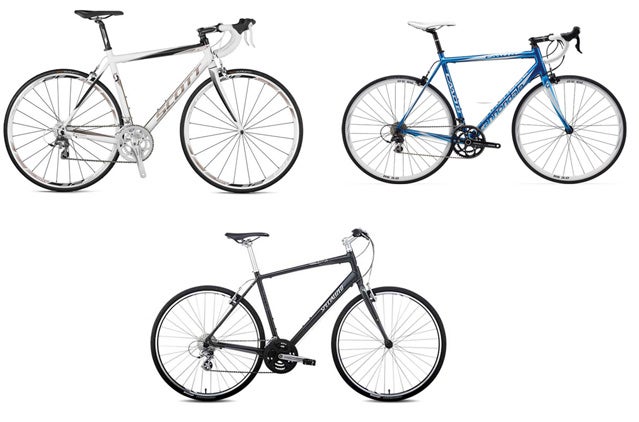Let’s start by stating the obvious: we take bike testing seriously at ���ϳԹ���. We review bikes year-round, riding some 100 bikes annually and logging hundreds of miles on each bike that gets reviewed in the magazine. Our testing culminates in a seven-day trip in January that includes dozens of riders and stacks of bikes.
This year, after publishing the results of all that testing in the May Issue’s and the Summer 2012 Buyer’s Guide, requests poured in for reviews of less-expensive bikes. As some readers pointed out, we tend to focus on bikes that cost more. We do so because, in general, that’s where the bulk of development and innovation takes place. Also, bike prices have soared in recent years, meaning the dollar doesn’t go as far it used. But all your appeals got us wondering: What does a limited budget buy? And how cheap is too cheap?
Looking for answers, we sifted through dozens of lower-priced bikes out there to find the best values. Then we spent the past few months putting them to the test on the trails and roads around Santa Fe. And while it’s still true that you get what you pay for, we were pleasantly surprised by some of the great values we found. Last week we brought you three great values in mountain bikes. We continue the budget series this week with road bikes for $500, $1,000, and $1,500.
The Best Budget Road Bikes: Buying Advice
Shopping for a bike on a budget? Skip the bells and whistles.
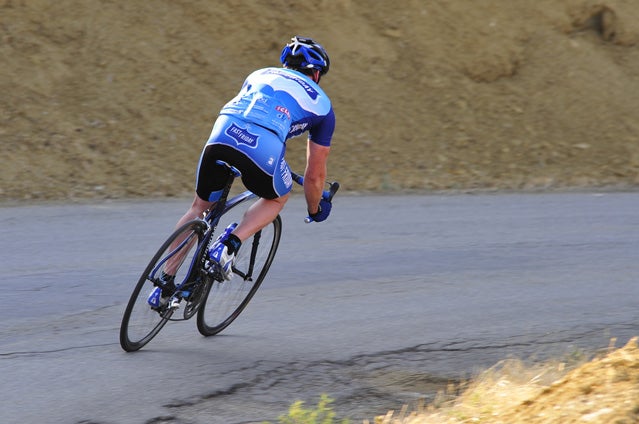
When it comes to road bikes, more money buys a lighter bike, refinement in the ride quality and fit, and more durable parts. The latter is less of a big deal on the road front than the mountain because riding pavement doesn’t take the toll on parts that riding rough trails does. And while you won’t get a new carbon fiber bike under $1,500, that’s actually not a bad thing, as many of the most inexpensive carbon frames are just cheap knockoffs that are heavier and ride more poorly than their aluminum counterparts. The truth is, we were impressed by just how good of a ride this much money buys. You won’t be getting the latest, greatest component technology or the same bikes that are ridden by the pros, but if you’re just getting into the sport you won’t miss or need those niceties anyway.
Much of the same advice we doled out for mountain bikes applies to road bikes, too. Head for a reputable bike shop, not a department store, because not only are you more likely to get good quality parts and brands, but the shop will be more apt to help you with initial fit, accessories like pumps and multitools to keep your new ride rolling, and tune-ups when inevitable break-in issues like cable stretch appear. When purchasing, don’t be afraid to ask about switching parts (a stem or saddle, for instance) if something about the bike you’re considering is uncomfortable or not working. And take a few bikes out for test rides for comparison; most good shops will let you spin around the parking lot or nearby blocks in exchange for a driver’s license or credit card.
There’s an unfortunate tendency among new road riders to want to get a bike that looks like the ones the pros ride. Resist this urge and opt for bikes with a more comfortable fit. Whereas pro riders are conditioned for extreme positions, which they need to reap the aerodynamic benefits, the rest of us will benefit from an easier, more upright fit that makes us comfortable when we ride. You can compare geometry numbers for an accurate sense of this (look for shorter top tubes, taller head tubes, and shorter stems with more rise), or simply sit on a few bikes and judge which one is the most comfortable.
As far as parts go, the more bits and pieces on a bike from the big cycling industry manufacturers, like Shimano and SRAM, the better. Since these companies build parts for the very best bikes on the market as well as budget bikes, their entry-level equipment has serious trickle-down performance benefits. As far as gearing, look for a triple chain ring up front, which yields more. If the bike comes with a double chain ring, make sure it is a compact (50 x 34). More expensive bikes and the ones pros ride often come with bigger rings (53 x 39), but those gears can be too difficult for recreational riders to push, especially given the extra weight of less expensive bikes.
Finally, and perhaps most importantly, consider buying a used bike or a previous year’s model. While it’s great to buy new, the consignment racks at your local bike shop or online vendors like Craigslist can yield great bikes at half the cost you’d pay for them new. And since road bikes generally take a lot less abuse than mountain bikes, used bicycles often look and ride just like new ones. For the best deals, shop at the end of the season (fall and winter), when bike shops frequently drop prices to clear out last year’s inventory.
The Best $500 Road Bike: Specialized Sirrus
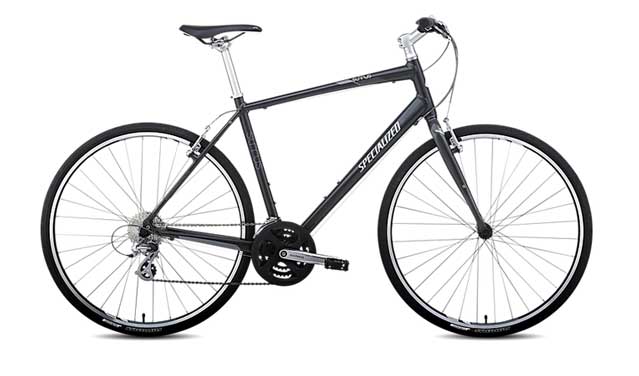
Like almost every road bike in this price range, the ($500) is equipped with flat bars, thicker tires, and other commuter-oriented features. It might not look like the quintessential roadie, but that’s just the point: The upright fit helps ease newcomers into the sport comfortably, and the crossover orientation means the bike will be useful around town as well as on the open road.
THE FRAME
Aimed at comfort first and speed second, the Sirrus’ extremely tall head tube put us in a vertical riding position reminiscent of a cruiser bike. It was perfectly comfortable and made for slow, steady steering, but the true roadies among us complained that the position created too much drag to keep up when riding in a group. Back in town, rack and fender mounts and extra wide tire clearance make this a seriously versatile ride.
THE PARTS
At first we bristled at the flat bars, which are seemingly anathema to a quick road riding position, but after a few tests we realized our complaint is less with the bars than the incredibly long, tall (20-degree) stem. We’re all for comfort, but the combo of tall head tube and gargantuan stem steers the Sirrus out of the road realm into the full-on commuter zone. When we swapped in a shorter flatter stem, however, the bike piloted more like the road bike we expected. The shifting was okay, braking power was a bit sluggish, but both functioned reliably well. Ditto the 32mm tires. We wish more manufacturers would spec fatter tires on enthusiast level bikes because, as was the case here, the smooth ride far outweighed any arguments about added drag.
THE BOTTOM LINE
Specialized bills the Sirrus as being as comfortable on the open pavement as it is in the city. That might be true of the more expensive models (the $2,100 top-end Limited gets a carbon frame and damping features borrowed from even pricier bikes), but the base Sirrus we tried is definitely best suited to townie riding. For around-town errands and even long commutes, it’s a solid bet as the rugged frame and beefy wheel set will stand up to abuse. And if you’re willing to tinker with parts (especially subbing in a stem), it can pull double duty on casual road rides with friends. In that sense, the Sirrus is a good, inexpensive everyday bike that allows those curious about road riding to give it a shot without committing to more than one bicycle.
The Best $1,000 Road Bike: Scott Speedster S40
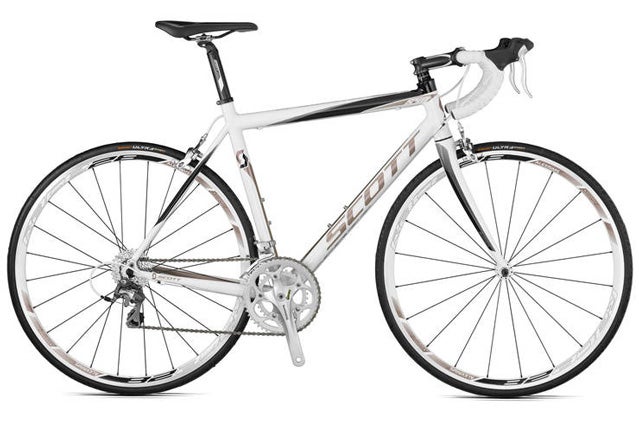
With the ($850), Scott has leveraged its considerable know-how from building pro-level racers like the Addict and the Foil to create a fast, stable, hard-working road bike for the average rider. It’s not without its flaws—a few components in particular—but the good here far outweighs the bad, especially considering the price. Bonus: it looks a lot more expensive that its price tag suggests.
THE FRAME
With the exception of a taller head tube, the geometry on the Speedster is darn close to Scott’s flagship road bike, the Foil. That’s a good thing on both counts: We absolutely loved the Foil’s agility and quick handling, and the added height up front here simply makes the steering a bit calmer and the fit a bit easier for non-racers. It was well balanced if a bit husky on climbs and steady when descending. But where we really felt this bike excelled was on flats and rolling terrain, where it hummed along like a bowling ball. Unlike some other frames out there, which take advantage of tube hydroforming to shape and tweak the ride quality, the Speedster’s straight aluminum tubing was definitely a bit jarring on rough roads. Having said that, we found that fiddling with tire pressure—especially running less than suggested, say 75 to 80 psi—can really quiet the chatter on any bike, the Speedster included.
THE PARTS
Before we begin nitpicking, it’s worth saying that overall the components on this bike worked just fine, and the average user who has never ridden high-end bikes will have nary a complaint. With that said, there is a noticeable gap between the performance of these parts and mid-grade components like Shimano 105. The positioning of Campagnolo-esque thumb shifters on the Shimano Sora controllers means there’s absolutely no possible way to shift while in the drops. We also were surprised just how far over you have to push the brake paddle to shift up, which could be a problem for women and those with small hands. And, most important, the braking power was underwhelming. As for the drivetrain, the 50 x 34 gearing up front combined with the 28-tooth granny gear in the back provided ample range for even the steepest pitches on our local hill climb, and while shifting was quick and accurate, overall the parts felt a bit fragile. Again, everything works just fine—you simply get what you pay for.
THE BOTTOM LINE
In spite of all that grousing, we actually really, truly like the Speedster. Considering that it costs less than what many companies are selling wheels for these days, it is a great value. While the parts are a bit blah, the frame is well built and the bike tips the scales at a svelte 20.2 pounds. That makes it especially suitable for aspiring roadies and even the budding racer—it rides great out of the box, and as time and budget allows, upgraded components will simply make this a sweeter and faster ride. For the price, it’s hard to imagine a smoother, better-looking road bike.
The Best $1,500 Road Bike: Cannondale CAAD8 5 105
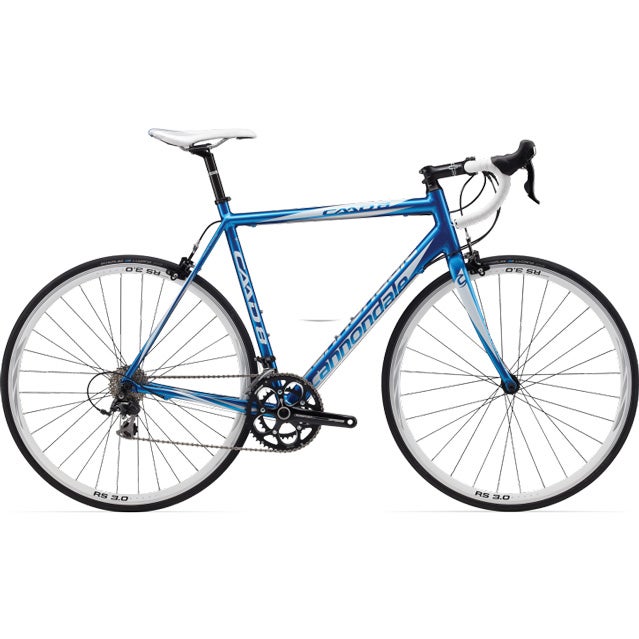
Having tested and absolutely loved Cannondale’s top-shelf aluminum race bike, we were anxious to see how the CAAD8 ($1,450) compared. The short answer is, very, very well. At 19 pounds, this bike won’t supplant its more expensive (and three pounds lighter) sibling—and it isn’t intended to. Instead, it brings the exceptional performance of the family line to a much broader audience.
THE FRAME
Though it’s built of a lesser quality aluminum than the CAAD10 and the tubes are mechanically shaped not hydroformed, this bike looks and rides almost as well as its more expensive counterpart. The geometry is virtually the same, meaning you get a time-tested, race-worthy bike for surprisingly little money. We were shocked how snappy it was in sprints and hard accelerations, and it felt much more willowy and light on long climbs than its weight suggests. At this price, the only thing we might change about this frame is the styling: the red-on-black is a bit disco for our tastes, but the electric blue grows on you.
THE PARTS
For our money, there is simply no better value in road bike parts than Shimano 105. It wouldn’t be fair to say that these components perform as well as Ultegra or Dura Ace, the more expensive upgrades, but they are admirably close given the big difference in price. The shifting was crisp and exact, and we felt no consternation really pushing hard on these parts. It’s a shame that Cannondale spec’d Tektro brakes rather than 105, but clearly price dictated and to be fair the stopping power is much greater than that of either of the other brakes in this review. The one uninspiring choice is the wheels (Formula hubs laced to Maddux rims), which are smooth rolling but relatively heavy. Then again, they’re light for this price point; we were just wooed into wanting more by the standout performance elsewhere. Even the saddle, a nondescript house-branded variety, was pleasantly and surprisingly comfortable.
THE BOTTOM LINE
It’s tempting to call this a great budget bike, but the truth is that it’s great apart from the price. It compares favorably up against bikes double its cost. For the budget rider, it presents incredible value and performance for minimal commitment. And for the seasoned rider, it’s one heck of a backup. Though lots of expensive bikes roll through our offices, we’d be more than happy to have the CAAD8 as our training ride. In fact, it’s even a perfect criterium bike because not only is it relatively light and fast, the muscly aluminum build means it will brush off scuffles and crashes. Simply, the CAAD8 costs 60 percent less than the astoundingly light and quick CAAD10, which would be at home in Cat. 1 races, but it comes a lot closer than that in terms of flat-out performance. If this is your price range, you will not buy a better bike, period.


